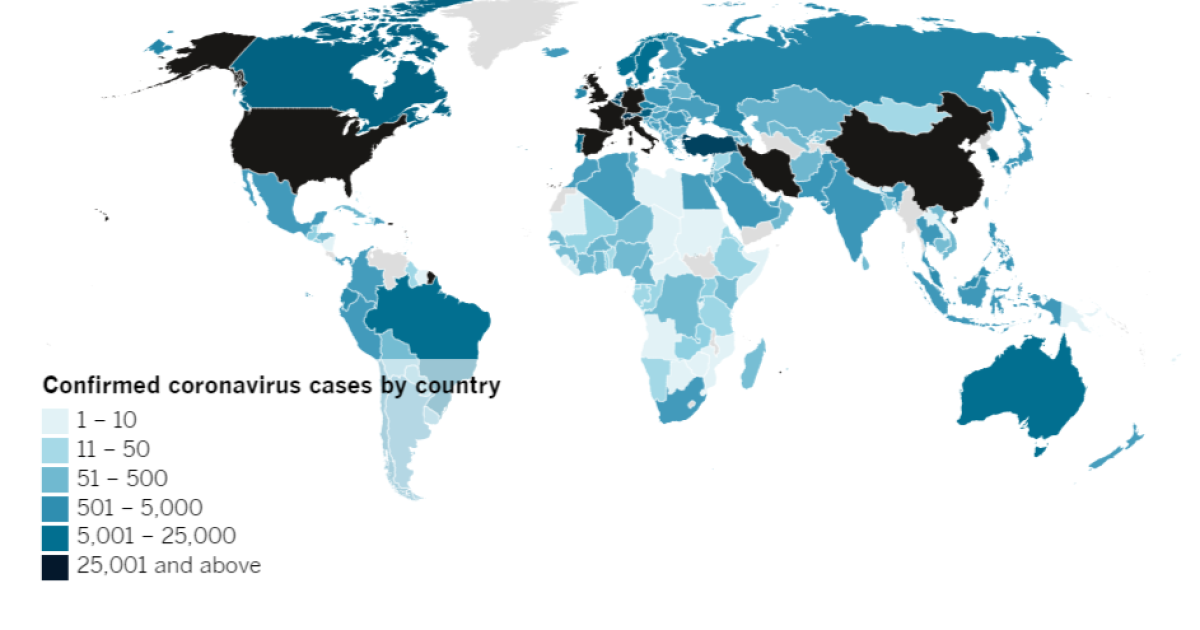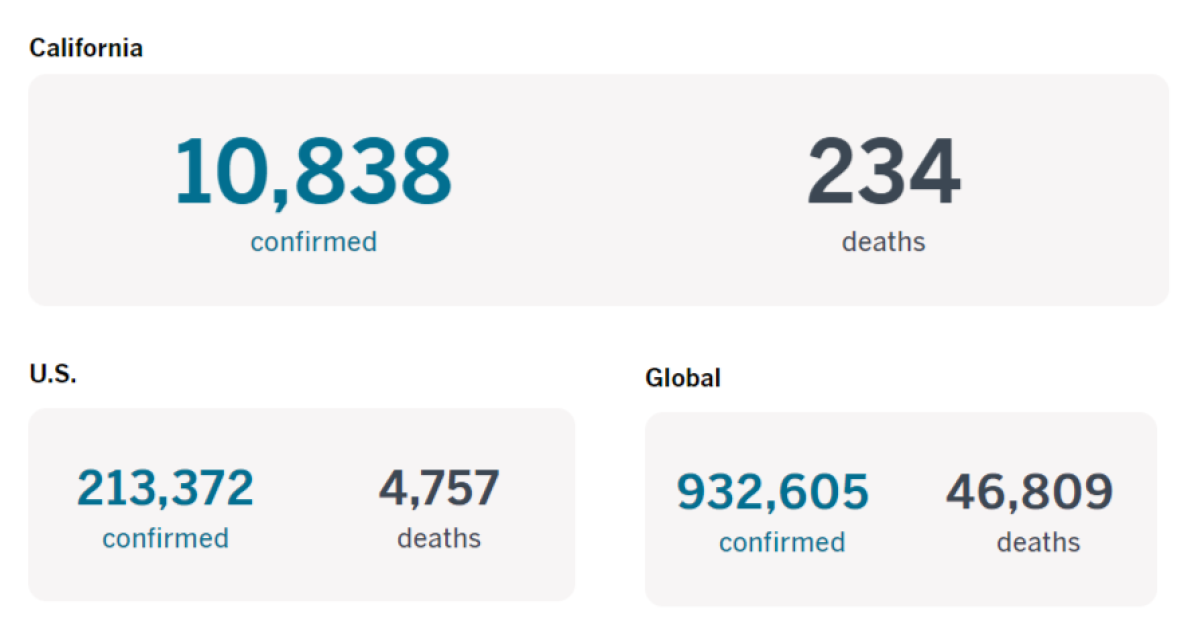Coronavirus Today: Two bleak milestones
Good evening. I’m Diya Chacko, and it’s Thursday, April 2. Here’s what’s happening with the coronavirus outbreak in California and beyond.
We’ve reached a bleak milestone in the coronavirus pandemic: 1 million confirmed infections worldwide, and more than 50,000 deaths. (The true numbers are believed to be much higher, in part because of differences in counting practices, testing shortages and unreported mild and asymptomatic cases.) And here’s another grim record: 10 million Americans have applied for unemployment in just two weeks.
More than 1.6 million Californians are out of work, including a 38-year-old single mother who, along with her co-workers, was laid off without severance or health insurance from her job as a housekeeper at a luxury hotel in Beverly Hills. Her struggle over the last three weeks is a lesson in survival in how one modest family copes at a time when the nation’s threadbare safety net has come into sharp relief.
Many of Los Angeles County’s whitest and wealthiest enclaves are reporting far higher rates of infection than poorer neighborhoods of color. But that doesn’t mean the virus is spreading more widely there, officials and experts say. Rather, that gap is probably due to uneven access to testing and wealthy people’s international travel, and reflects troubling disparities along the lines of race, income and immigration status.
Two months before the virus probably began spreading in Wuhan, China, the Trump administration ended a $200-million pandemic early-warning program aimed at training scientists in China and other countries to detect and respond to such a threat. The project, launched in 2009 in response to the 2005 H5N1 “bird flu” scare, identified 1,200 viruses that had the potential to erupt into pandemics, including more than 160 novel coronaviruses. Trump has come under increased criticism for past moves to downgrade global health security, including proposals to slash funding to science agencies and the elimination of the National Security Council’s key global health post.
As competition for personal protective equipment, ventilators and other supplies snowballs in the open market, the U.S. and California have done little to intervene. Hospitals are competing with each other, fake supplies are flooding the market and price gouging is rampant. Nurses and doctors are pleading for donations online, telling stories of reusing masks and turning trash bags into makeshift gowns. Those on the front lines say the state should step up efforts to buy and distribute key items and ensure they go to those with the greatest need, not just to those with money and luck.
In communities across the nation, neighbors are taking steps to look out for each other, helping with with grocery runs, meals, pharmacy pickups, check-in calls and other errands. “Our government is already at capacity right now,” said one volunteer coordinator. “We really need to show up as neighbors for each other right now and fill in the gaps.”
By the numbers
Cases as of 4 p.m. PDT Thursday:
Track the latest numbers and how they break down by county and state with our graphics.
Where is the coronavirus spreading?

Your support helps us deliver the news that matters most.
Across California
The number of cases in California has swelled to more than 10,000, with the death toll topping 200. In our effort to cover this pandemic as thoroughly as possible, The Times would like to hear from the loved ones of people who have died from COVID-19. If you’ve got a story to share, please consider submitting it here.
Some good news: Californians won’t have their water turned off because of unpaid bills, and those who have already had it turned off will have their service restored. Gov. Gavin Newsom’s directive comes in response to calls from environmental justice organizations for assistance to low-income residents.
L.A.’s efforts to get homeless people off the streets and to secure rooms for sick people to stay without infecting others are off to an uneven start. So far, L.A. County’s quarantine and isolation sites have remained largely empty, while its plan to bolster the network by adding thousands of beds in hotels and motels is just getting underway. Most homeless people who now have shelter are being housed in hotels and motels that have lost business because of the pandemic.
Construction workers have been deemed essential, along with plumbers, electricians and others who maintain homes and keep construction sites humming. New houses and buildings are still rising in L.A. — work that officials argue is needed to tackle the housing crisis. But renovation work on existing buildings has become a much bigger headache for tenants as more stay home during the day, and many worry about not only themselves but the safety of the workers.
As schools across California closed to prevent the virus’ spread, millions of working parents suddenly became de facto teachers, principals and day-care providers, too. Many of them work remotely; others work essential jobs, including as healthcare providers, and have been forced to rely on nearby family or friends for childcare when they go to work, making complete self-isolation impossible. The Times talked with some about how they’re coping.
These days, the beach is one of the most dangerous places to be, even with social distancing, in the estimation of one Scripps Institution of Oceanography scientist. Her research suggests that the coronavirus could enter coastal waters via runoff from rain and poor sewage and spray back into the air through wave action. The six-feet rule, she said, doesn’t apply at the beach, where coastal winds can send viral particles soaring. “I wouldn’t go in the water if you paid me $1 million right now,” she said.
How to stay safe
— Wash your hands for at least 20 seconds! Here’s a super-fun how-to video.
— Stop touching your face, and keep your phone clean.
— Watch for symptoms including fever, cough and shortness of breath. If you’re worried you might be infected, call your doctor or urgent care clinic before going.
— Practice social distancing, such as maintaining a six-foot radius of personal space in public.
— Consider wearing a mask if you leave your home for essential activities. A growing number of health officials are endorsing the idea, though the CDC has said they’re only necessary in certain circumstances.
— Here’s how to care for someone with COVID-19, from monitoring their symptoms to preventing the virus’ spread.
How to stay sane
— Was your job affected by the coronavirus? Here’s how to file for unemployment.
— Here are all the ways to stay virtually connected with your friends.
— Need groceries? Here’s how to stock up for staying home. You can also watch our video guide on YouTube.
— Visit our free games and puzzles page for daily crosswords, card games, arcade games and more.
— Here are some free resources for restaurant workers and entertainment industry professionals having trouble making ends meet.
— Advice for helping kids navigate pandemic life includes being honest about uncertainties, acknowledging their feelings and sticking to a routine. Here’s guidance from the CDC.
Around the nation and the world
Asian governments that appeared to be bringing the coronavirus under control are imposing new social restrictions as the numbers of infections — many from overseas — continue to rise. The stepped-up measures signal that fighting the disease will take much longer than anticipated and that governments must adapt as the threat evolves, epidemiologists say.
People who recover from the coronavirus may develop antibodies that could allow them to return to school or work, but tests to determine whether a person has become immune are just being developed in the U.S., which unlike Germany or the U.K. hasn’t come up with a cohesive plan for large-scale antibody testing. Experts say that delay could dash chances for a return to public life and leave officials with few options other than severe social restrictions until a vaccine or drug therapy is available.
Blood donation centers across the U.S. are ramping up efforts to collect plasma from people who have recovered from COVID-19 in hopes it could be used to save others. Convalescent plasma therapy uses blood products taken from people who have recovered from a viral infection and injects them into those still suffering. The experimental practice may have had some success in past outbreaks like the 1918 flu, but its true efficacy has not been proven in rigorous clinical trials.
The coronavirus has made obsolete the door-to-door solicitations and candidate rallies that defined election seasons for decades. As political operatives try to pull off a massive pivot in how presidential campaigns are run, digital experimentation is playing out at unprecedented scale right now. The vast armies of sidelined door knockers are being put to work finding potential voters online. Meanwhile, the Democratic National Convention has been pushed back a month.
Your questions answered
Today’s question comes from Shana McCann, who asks: Are homemade masks effective in preventing the spread of the virus?
Here’s what we know when it comes to wearing masks during the pandemic.
California officials said earlier this week that covering your face could help prevent you from becoming infected with the new coronavirus or from spreading it to others. N95 respirators provide the best defense against the coronavirus because they filter out 95% of airborne particles and keep them from entering the wearer’s nose and mouth, but officials have asked average people not to buy those or medical-grade masks because they’re desperately needed by health workers.
Although hand-sewn masks won’t block virus particles if you’re in proximity to someone who is sick, they will protect you from droplets containing the virus. Riverside County health officials recommended Monday that people wear face coverings while visiting the grocery store or pharmacy and on medical visits, adding that bandannas, fabric masks and neck gaiters are acceptable. “Fabric covers and bandannas can be washed and used again,” officials said in a statement.
The CDC has maintained that healthy people do not need to wear face masks in most circumstances but is weighing whether to modify those recommendations.
Here’s a guide to making your own mask. You can also watch this YouTube tutorial on how to make a no-sew mask.
Officials have stressed that mask-wearing should not be a substitute for social distancing, hand washing and other measures.
Got a question? Our reporters covering the coronavirus outbreak want to hear from you. Email us your questions, and we’ll do our best to answer them. You can find more answers in our Frequently Asked Questions roundup, and in our morning and midday briefing.
For the most up-to-date coronavirus coverage from The Times, visit our live updates page, visit our Health section and follow us on Twitter and on Instagram.





